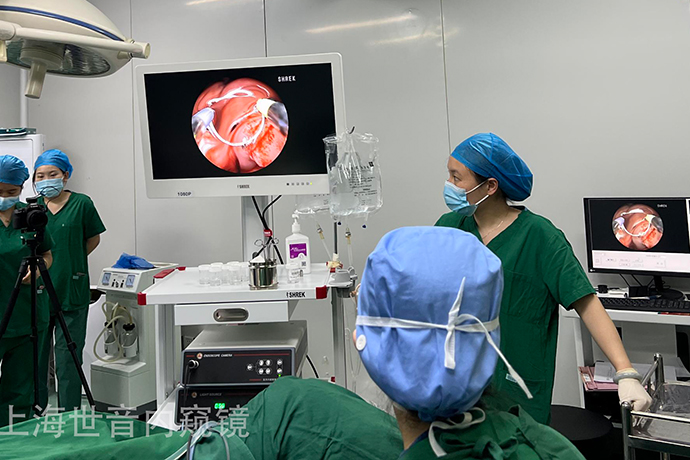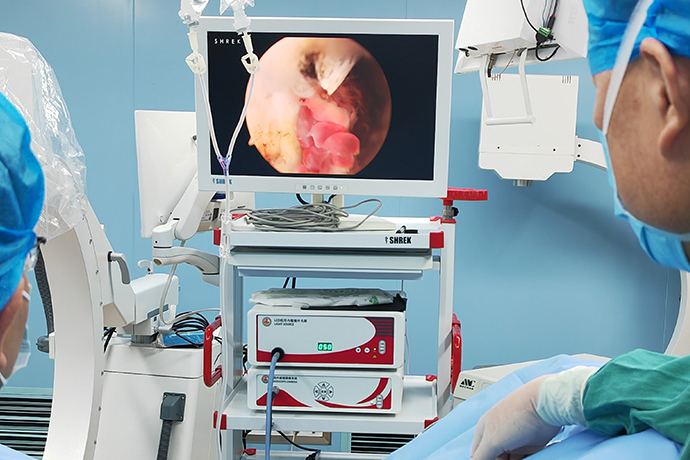[Gynecological Hysteroscopy] Complication prevention skills of hysteroscopic surgery
Release time: 01 Nov 2022 Author:Shrek
Hysteroscopic diagnosis and treatment of intrauterine lesions is minimally invasive and effective. Because hysteroscopic surgery requires energy equipment, uterine dilatation media, intrauterine pressure, and the operation space is narrow and cannot be sutured, its complications are different from traditional surgery, and even Risk of death. Common complications include uterine perforation, hemorrhage, fluid overload, hyponatremia, air embolism, and postoperative uterine rupture in pregnancy. safety of surgery.

1. Bleeding
There are many blood vessels in the endometrium. When performing endometrial resection, in order to avoid bleeding, the depth of the incision needs to be 2 to 3 mm below the endometrium. The main cause of intraoperative bleeding in hysteroscopic surgery is the deep destruction of the myometrium beneath the endometrium.
Risk factors: uterine perforation, arteriovenous fistula, placenta accreta, cervical pregnancy, cesarean section scar pregnancy and coagulation dysfunction.
Countermeasures: preoperative drug pretreatment (application of oxytocin and hemostatic drugs), intrauterine balloon compression, combined laparoscopic monitoring and preventive uterine artery occlusion, etc.
The treatment plan is determined according to the amount of bleeding, the site of bleeding, the extent and the type of surgery.
1. Uterine perforation
High-risk factors: cervical stenosis, history of cervical surgery, excessive uterine flexion, small uterine cavity, and inexperienced operators.
Clinical manifestations:
① The uterine cavity is collapsed and the vision is unclear.
② B ultrasound image shows free fluid around the uterus, or a large amount of perfusate into the abdominal cavity.
③ The peritoneum, bowel or omentum can be seen in hysteroscopy.
④ If there is laparoscopic monitoring, the uterine serous surface is clear, blisters, bleeding, hematoma or perforated wounds.
⑤ The electrode enters and damages the pelvic and abdominal organs, causing corresponding complications and symptoms.
Countermeasures: Carefully find the perforation site and decide the treatment plan. ①Uterine fundus perforation: fundus muscle hypertrophy, relatively few blood vessels, and less bleeding, so oxytocin and antibiotics can be used for observation. ② Perforation of the uterine wall and isthmus: It may damage the uterine blood vessels, and should be opened for exploration immediately. Bleeding at the perforation can be stopped by laparoscopic bipolar coagulation, and sutures are required for larger holes. ③ Unknown situation: Laparoscopy should be performed, even if the general condition is normal, to observe whether bleeding and its source. ④Postoperative pain management: Pain at 24 hours after surgery should be fully examined, and laparoscopic examination should be performed in time when uterine perforation is suspected.
Prevention:
① Strengthen cervical pretreatment and avoid violent dilation of the uterus. If the patient is postmenopausal, the cervix needs to be softened with drugs such as misoprostol before surgery. If the patient's cervical canal is stenotic, related drugs to dilate the cervix need to be used to ensure the smooth placement of the hysteroscope. enter.
② Combined with B-ultrasound or laparoscopic surgery as appropriate to clarify the location of the lesion and obtain a clear surgical field.
③ Training and improving the surgical skills of the surgeons.
④ Use GnRH-α drugs as appropriate to reduce the volume of fibroids or uterus, and thin the endometrium.
1. Perfusate overabsorption syndrome
In hysteroscopic surgery, the pressure of uterine distention and the use of non-electrolyte perfusion media can cause liquid media to enter the patient's body. When the absorption threshold of the human body is exceeded, a series of symptoms and signs are caused.
Clinical manifestations: including slow heart rate, increased or decreased blood pressure, nausea, vomiting, headache, blurred vision, restlessness, mental disorder and lethargy, etc. If the diagnosis and treatment are not timely, convulsions, cardiopulmonary failure and even death will occur.
Incentives: intrauterine high pressure, massive absorption of perfusion media, long operation time, etc.
Countermeasures: oxygen inhalation, diuresis, treatment of hyponatremia, correction of electrolyte imbalance and water intoxication, treatment of acute left heart failure, prevention and treatment of pulmonary edema and cerebral edema.
Special attention should be paid to the correction of dilutional hyponatremia, which should be calculated and supplemented according to the formula for sodium supplementation: required sodium supplementation = (normal serum sodium value - measured serum sodium value) 52% ×body weight (kg). The initial replenishment amount is 1/3 or 1/2 of the calculated total amount, and the subsequent replenishment amount is determined according to the patient's consciousness, blood pressure, heart rate, lung signs and changes in serum Na+1, K+1, and Cl-1 levels. Avoid rapid, high-concentration intravenous sodium supplementation, so as not to cause a temporary low osmotic pressure state in the brain, so that the fluid between the brain tissue is transferred into the blood vessels, causing dehydration of the brain tissue, resulting in brain damage.
The hysteroscopic bipolar electrical system uses normal saline as the intrauterine perfusion medium, which reduces the risk of hyponatremia, but still has the risk of fluid overload.
Prevention:
① Pretreatment of the cervix and endometrium helps to reduce the absorption of perfusate.
② Keep intrauterine pressure ≤ 100 mmHg or <mean arterial pressure.
③ Control the difference of perfusate between 1000-2000ml.
④ Avoid deep damage to the uterine muscle wall.
1. Gas embolism
Gas embolism is a very rare but fatal complication in hysteroscopic surgery. During hysteroscopic surgery, the air can enter the uterine cavity through the water inlet tube of the perfusion system, the cervix, the repeatedly entered uterine dilator and hysteroscopic instruments, and enter the venous system through the open blood sinus during the operation. The gas can enter the inferior vena cava, then enter the right heart, pulmonary artery, and finally the lungs, causing pulmonary hypertension, hypoxemia, circulatory failure, and cardiac arrest.
Tissue gasification and room air during the surgical operation may enter the venous circulation through the open blood vessels in the uterine cavity, resulting in gas embolism. The onset of gas embolism is sudden and the progress is rapid, with early symptoms such as end-expiratory PCO2 drop, bradycardia, PO2 drop, and a large water wheel sound in the precordial area; followed by increased blood flow resistance, decreased cardiac output, cyanosis, He died of hypotension, shortness of breath, and cardiopulmonary failure.
Countermeasures: stop the operation immediately, inhale oxygen at positive pressure, and correct cardiopulmonary failure; at the same time, enter normal saline to promote blood circulation, place central venous catheter, and monitor cardiopulmonary arterial pressure.
Specific measure:
① The mechanical pump used for intraoperative injection of dilatation fluid should be equipped with a Y-shaped connecting tube to prevent air from entering the perfusion tube.
② Set a reasonable pressure of uterine distention fluid. As mentioned above, the pressure of uterine distention fluid is generally not more than 100mmHg, and the dosage of uterine distention fluid is controlled at the same time.
③ During the electric cutting operation, tissue vaporization can generate more gas, and the use of cold knife instruments or shortening the operation time as much as possible can reduce the generation of gas.
④ After the cervix is dilated, the operator should keep the cervix in a closed state during the operation to avoid repeated entry and exit of instruments into and out of the uterine cavity.
⑤ Intraoperative quick identification: Anesthesiologists should pay attention to the monitoring of end-tidal carbon dioxide partial pressure during hysteroscopy. The decrease of end-tidal carbon dioxide partial pressure is a sensitive indicator of early gas embolism.
⑥ Once a gas embolism is found, the operation should be stopped immediately, the fluid in the uterus should be emptied, and a wet gauze should be placed in the vagina to prevent the gas from entering. Immediately place the patient's head in a high position to elevate the heart to reduce gas entry.
Prevention:
① Avoid a high position with your head down and your hips high.
② Evacuate the gas in the water injection pipe before surgery.
③ Pretreatment of the cervix is performed to avoid cervical laceration caused by rough dilation of the uterus.
④ Strengthen intraoperative monitoring and emergency treatment.
1. Preventive measures for intrauterine adhesions
① Use needle electrodes to cut the mucosa and the capsule of the fibroids on the surface of the protruding fibroids in the uterine cavity, and then use the ring electrodes to cut the tumor body, try not to damage the normal endometrium around the tumor body to prevent secondary postoperative complications The key to sexual intrauterine adhesions.
②If there is a large exposed wound in the uterus or the preoperative application of GnRH-a treatment causes low estrogen in the patient's body, an appropriate amount of estrogen after surgery can stimulate the growth of the endometrium, accelerate the epithelialization process, and prevent the occurrence of intrauterine adhesions.
③ The IUD can also be placed at the end of the operation. If there is a lot of bleeding during the operation, it can be placed after the menstrual cramps after the operation, and the physical support of the IUD can prevent the occurrence of intrauterine adhesions.
1. Infection
Incentives:
① The doctor did not strictly follow the aseptic operating procedures for the operation.
② The patient was not strictly examined for pelvic and vaginal secretions before surgery.
Prevention:
① Strictly grasp the indications for surgery.
② Surgery is contraindicated in acute stage of reproductive tract infection.
③ Postoperative antibiotics should be used as appropriate to prevent infection.
1. Treatment failure and recurrence
If treatment fails or symptoms recur, follow-up treatments can be selected as appropriate, including secondary hysteroscopic surgery, drugs, or hysterectomy. It is particularly emphasized that hysteroscopic surgery is a conservative surgery for the treatment of uterine diseases. Before surgery, the obligation of informed consent should be fully fulfilled, and it should not be forced to perform surgery against the wishes of patients.
Two major misunderstanding warnings, have you been recruited?
Myth 1: Electrosurgery is more likely to damage the endometrium?
No matter what kind of instrument operation, we advocate linear incision, local removal of lesions, little damage to the intima, and no loss of large pieces of intima. Therefore, there was no difference in the effect of electrocautery or cold knife on the endometrium, and there was no difference in postoperative success rate or natural pregnancy rate. Therefore, you don't have to worry about the electric knife.
Misunderstanding 2: If the hysteroscope needs to scrape the endometrium, will it thin the endometrium?
The answer is negative.
The purpose of hysteroscopy is not only to visually check the shape of the uterine cavity and the presence or absence of lesions, but also to evaluate the endometrium. In addition to the visual inspection of endometrial thickness, color, and gland opening, the endometrial assessment also needs to take endometrial tissue and observe under a microscope whether there are pathological changes and prevent canceration. This check is essential.
One thing needs to be explained, what we call "hysteroscopic curettage", in fact, the accurate term should be "endometrial arrangement" or "endometrial sampling", the purpose is to scrape a small amount of endometrial for pathological examination and stimulation. The endometrium releases cytokines that are beneficial to embryo implantation. It is not a "dilation and curettage" in the traditional sense, so the endometrium will not be thinned!

- Recommended news
- 【General Surgery Laparoscopy】Cholecystectomy
- Surgery Steps of Hysteroscopy for Intrauterine Adhesion
- [Gynecological Hysteroscopy] Techniques for Preventing and Treating Complications of Hysteroscopic Surgery
- [Gynecological Hysteroscopy] Hysteroscopic Adhesiolysis
- [Gynecological Hysteroscopy] IUD Removal under Hysteroscopy